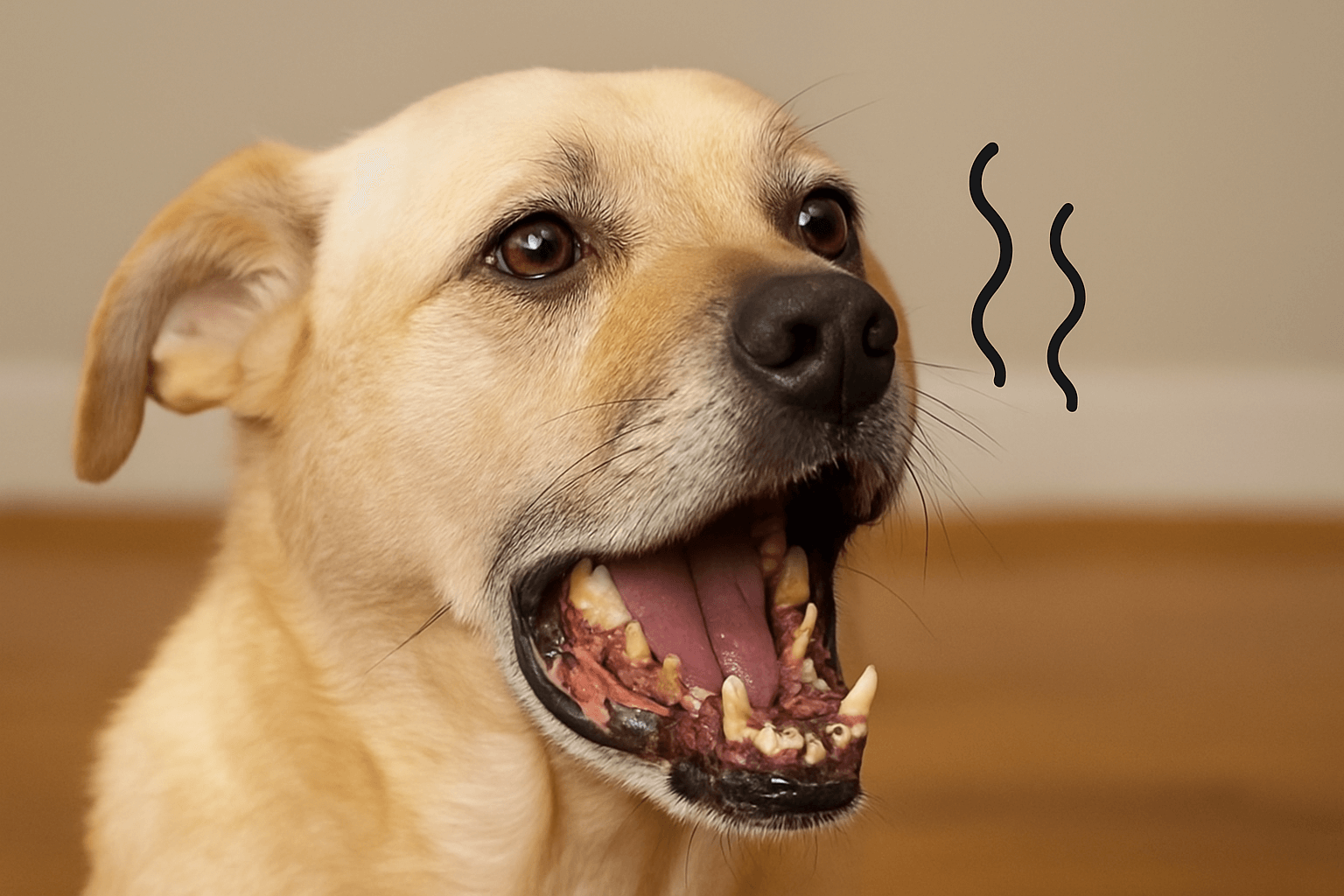If your pup’s kisses make you want to hold your breath, it’s time to dig deeper than a minty dog treat. Bad dog breath—or dog halitosis—is often more than just a smelly inconvenience. It can be one of the earliest signs of dental disease, which affects up to 80% of dogs by age 3. As a lifelong dog mom and pet wellness blogger, I’ve seen just how much dog breath and oral health are connected—and how easily we can miss the signs.
Why Does My Dog's Breath Smell So Bad?
Let’s bust a myth: dog breath isn’t supposed to smell "normal" bad. Persistent odor is your dog’s way of waving a red flag. Here are the most common bad dog breath causes:
- Built-up plaque and tartar: These harbor bacteria that smell—and do damage.
- Gum infections: Inflammation and bleeding gums often produce a metallic or rotten smell.
- Tooth decay: Rotting teeth can cause seriously foul breath.
- Poor diet: Low-quality foods or sneaky trash raids can sour the breath.
- Underlying health issues: Diabetes, kidney disease, and digestive problems can also be culprits.
Understanding Dog Dental Disease
Dog dental disease (aka periodontal disease) is a progressive condition that starts with gingivitis and can lead to tooth loss, infection, and pain. It’s the #1 diagnosed disease in dogs—and it’s entirely preventable. The bacteria from neglected mouths can even enter the bloodstream, affecting the heart, liver, and kidneys. Yup, doggy breath just got serious.
Signs of Dental Problems in Dogs
Some dogs are stoic, but their mouths tell the truth. Here are common signs of dental problems in dogs:
- Bad breath that doesn’t go away
- Red or bleeding gums
- Difficulty chewing or dropping food
- Yellow or brown teeth
- Pawing at the mouth or face
- Visible tartar buildup
- Swelling around the jaw
My own senior rescue, Lulu, started showing subtle signs—ignoring her kibble and licking her lips frequently. A dental checkup revealed two infected teeth. After treatment and proper dental care, her breath improved, and she had a new pep in her step!
What You Can Do: Dog Breath and Oral Health Tips
Preventing dog dental disease starts with consistent care. Here’s what works:
- Brush daily (or at least a few times a week): Use a dog-specific toothbrush and enzymatic toothpaste.
- Dental chews: Look for VOHC-approved chews that reduce plaque.
- Regular cleanings: Your vet may recommend yearly professional dental cleanings, especially for small breeds.
- Water additives & dental sprays: These can support oral hygiene in between brushes.
- Diet matters: Consider foods that promote dental health. (Check out our guide to healthy treats for dogs.)
When to Call the Vet
If your dog’s breath suddenly worsens, or you notice bleeding, swelling, or appetite changes, it’s time to schedule a dental exam. Don’t wait—it’s much easier (and cheaper) to treat early-stage issues.
Final Thoughts: Don’t Ignore the Stink
We love everything about our dogs—even their slobbery kisses—but bad dog breath isn’t something to ignore. It’s often your pup’s way of saying, “Help!” Prioritize dog breath and oral health as part of your wellness routine, and your furry friend will thank you with healthier gums, a happier tummy, and yes—fresher breath!
Need help choosing the right dental products for your pup? Stay tuned for our upcoming roundup of best dog dental chews and toothbrush kits.
Frequently Asked Questions (FAQs)
1. What causes bad breath in dogs?
2. Is bad breath a sign of dental disease in dogs?
3. How can I improve my dog’s breath at home?
4. Can dental disease in dogs lead to other health problems?
5. How often should a dog get a dental cleaning?
6. What are safe treats for better dog breath?

About SniffnTail
SniffnTail is your go-to destination for everything pets. From helpful advice, tips, and insights to thoughtfully selected products and resources, we’re here to support pet owners at every stage of their journey. Whether you're caring for a playful pup, a wise old cat, or anything in between, SniffnTail offers tools and knowledge to make pet parenting easier and more joyful.
Related Articles
 Health & Wellness • 7 min read
Health & Wellness • 7 min readGolden Retriever Abandonment Issues: When Loyalty Becomes Anxiety
Explore how extreme attachment behaviors and waiting behaviors in Golden Retrievers can lead to anxiety, and learn how to help your loyal pup cope.
 Health & Wellness • 5 mins Read
Health & Wellness • 5 mins ReadVaccines for Dogs: What Every Pet Parent Should Know
Vaccinating your dog is one of the most important things you can do to ensure their long-term health and protect them—and your family—from potentially deadly diseases. Understanding the dog vaccine schedule, knowing dog vaccines names, being aware of annual vaccines for dogs, and recognizing potential adverse reactions to vaccines can help you make informed decisions for your furry friend.
 Health & Wellness • 8 min read
Health & Wellness • 8 min readCavalier King Charles Spaniel Neurological Pain and Anxiety: Signs, Support & Solutions
Explore how CM/SM-related behavioral changes and pain-induced fear affect Cavalier King Charles Spaniels. Learn to recognize signs of neurological pain and support your dog with expert tips.

